Hola amigos: A VUELO DE UN QUINDE EL BLOG., hemos recibido información del: The National Science Foundation (NSF), interesante celebrando el Día de la Tierra, donde ellos ha detectado cambios en el ecosistema, pero esta vez han tomado como un ejemplo a las diminutas plantas carnívoras.
Donde en una gota de agua son encontrados todos los elementos y secretos de todos los océanos.
¿Qué hace una charca o un lago y una planta de jarra carnívora tienen en común?
Los investigadores usan plantas de jarra para identificar los signos de problema de muerte mas adelante.Los invito a leer todo el informe en idioma inglés.....
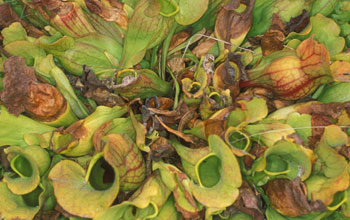
In scientists' eyes, each leaf of the northern pitcher plant is a small ecosystem.
Credit: Aaron Ellison
Download the high-resolution JPG version of the image. (361 KB)
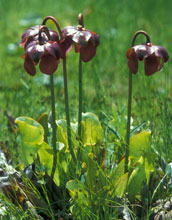
The northern pitcher plant is known to biologists as Sarracenia purpurea for its purple color.
Credit: Aaron Ellison
Download the high-resolution JPG version of the image. (1.1 MB)
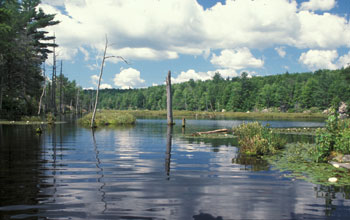
Water-filled pools in pitcher plants have ecological dynamics similar to ponds and lakes.
Credit: Aaron Ellison
Download the high-resolution JPG version of the image. (580 KB)

Oxygen sensors inside a northern pitcher plant reveal when a tipping point is reached.
Credit: John Hirsch
Download the high-resolution JPG version of the image. (74 KB)
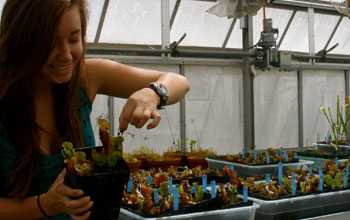
As part of experiments, ecologist Jennie Sirota feeds a wasp to a pitcher plant.
Credit: Ben Baiser
Download the high-resolution JPG version of the image. (1 MB)
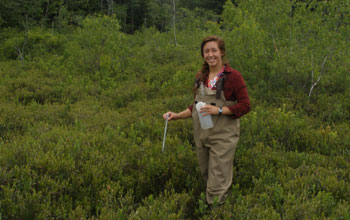
Jennie Sirota conducts research deep within the confines of a dark bog.
Credit: Ben Baiser
Download the high-resolution JPG version of the image. (1.3 MB)
In one drop of water are found all the secrets of all the oceans.
---Kahlil Gibran
What do a pond or a lake and a carnivorous pitcher plant have in common?
The
water-filled pool within a pitcher plant, it turns out, is a tiny
ecosystem whose inner workings are similar to those of a full-scale
water body.
Whether small carnivorous plant or huge lake, both are
subject to the same ecological "tipping points," of concern on Earth
Day--and every day, say scientists.
The findings are published in this week's issue of the journal Proceedings of the National Academy of Sciences.
In
the paper, ecologists affiliated with the National Science Foundation
(NSF) Harvard Forest Long-Term Ecological Research site in Massachusetts
offer new insights about how such tipping points happen.
"Human
societies, financial markets and ecosystems all may shift abruptly and
unpredictably from one, often favored, state to another less desirable
one," says Saran Twombly, program director in NSF's Division of
Environmental Biology, which funded the research.
"These
researchers have looked at the minute ecosystems that thrive in pitcher
plant leaves to determine early warning signals and to find ways of
predicting and possibly forestalling such 'tipping points.'"
Life
in lakes and ponds of all sizes can be disrupted when too many
nutrients--such as in fertilizers and pollution--overload the system.
When
that happens, these aquatic ecosystems can cross "tipping points" and
change drastically. Excess nutrients cause algae to bloom. Bacteria
eating the algae use up oxygen in the water. The result is a murky
green lake.
"The first step to preventing tipping points is
understanding what causes them," says Aaron Ellison, an ecologist at
Harvard Forest and co-author of the paper. "For that, you need an
experiment where you can demonstrate cause-and-effect."
Ellison and other scientists demonstrated how to reliably trigger a tipping point.
They
continually added a set amount of organic matter--comparable to
decomposing algae in a lake--to a small aquatic ecosystem: the tiny
confines of a pitcher plant, a carnivorous plant native to eastern North
America.
Each pitcher-shaped leaf holds about a quarter of an
ounce of rainwater. Inside is a complex, multi-level food web of fly
larvae and bacteria.
"The pitcher plant is its own little
ecosystem," says Jennie Sirota, a researcher at North Dakota State
University and lead author of the paper.
Similar to lake
ecosystems, oxygen levels inside the water of a pitcher plant are
controlled by photosynthesis and the behavior of resident organisms--in
this case, mostly bacteria.
Ellison says that conducting an experiment with bacteria is like fast-forwarding through a video.
"A
bacterial generation is 20 minutes, maybe an hour," he says. "In
contrast, fish in a lake have generation times of a year or more.
"We would need to study a lake for 100 years to get the same information we can get from a pitcher plant in less than a week."
The same mathematical models, Ellison and colleagues discovered, can be used to describe a pitcher plant or a lake ecosystem.
To approximate an overload of nutrients in pitcher-plant water, the team fed set amounts of ground-up wasps to the plants.
"That's equivalent to a 200-pound person eating one or two McDonald's quarter-pounders every day for four days," says Ellison.
In
pitcher plants with enough added wasps, an ecosystem tipping point
reliably occurred about 45 hours after the start of feeding.
The scientists now have a way of creating tipping points. Their next step will be to identify the early warning signs.
"Tipping points may be easy to prevent," says Ellison, "if we know what to look for."
Other authors of the paper are Benjamin Baiser of Harvard Forest and Nicholas Gotelli of the University of Vermont.
-NSF-
Media Contacts
Cheryl Dybas, NSF (703) 292-7734
cdybas@nsf.gov
Clarisse Hart, Harvard University (978) 756-6157
Clarisse Hart, Harvard University (978) 756-6157
Related WebsitesNSF "Discoveries in Long-Term Ecological Research" Publication:
http://www.nsf.gov/pubs/2013/nsf13083/nsf13083.pdf?WT.mc_id=USNSF_25&WT.mc_ev=click
NSF LTER Network:
NSF LTER Network:
http://www.lternet.edu
NSF Harvard Forest LTER Site:
NSF Harvard Forest LTER Site:
http://harvardforest.fas.harvard.edu/
NSF Discovery Article: At Harvard Forest, Are Autumn's Reds and Golds Passing Us By?: http://www.nsf.gov/discoveries/disc_summ.jsp?cntn_id=125511
NSF Discovery Article: At Harvard Forest, Are Autumn's Reds and Golds Passing Us By?: http://www.nsf.gov/discoveries/disc_summ.jsp?cntn_id=125511
The National Science Foundation (NSF) is an independent federal
agency that supports fundamental research and education across all
fields of science and engineering. In fiscal year (FY) 2012, its budget
was $7.0 billion. NSF funds reach all 50 states through grants to nearly
2,000 colleges, universities and other institutions. Each year, NSF
receives about 50,000 competitive requests for funding, and makes about
11,500 new funding awards. NSF also awards about $593 million in
professional and service contracts yearly.
Useful NSF Web Sites:
NSF Home Page: http://www.nsf.gov
NSF News: http://www.nsf.gov/news/
For the News Media: http://www.nsf.gov/news/newsroom.jsp
Science and Engineering Statistics: http://www.nsf.gov/statistics/
Awards Searches: http://www.nsf.gov/awardsearch/
NSF Home Page: http://www.nsf.gov
NSF News: http://www.nsf.gov/news/
For the News Media: http://www.nsf.gov/news/newsroom.jsp
Science and Engineering Statistics: http://www.nsf.gov/statistics/
Awards Searches: http://www.nsf.gov/awardsearch/
The National Science Foundation (NSF).
Guillermo Gonzalo Sánchez Achutegui
ayabaca@gmail.com
ayabaca@hotmail.com
ayabaca@yahoo.com
Inscríbete en el Foro del blog y participa : A Vuelo De Un Quinde - El Foro!

No hay comentarios:
Publicar un comentario